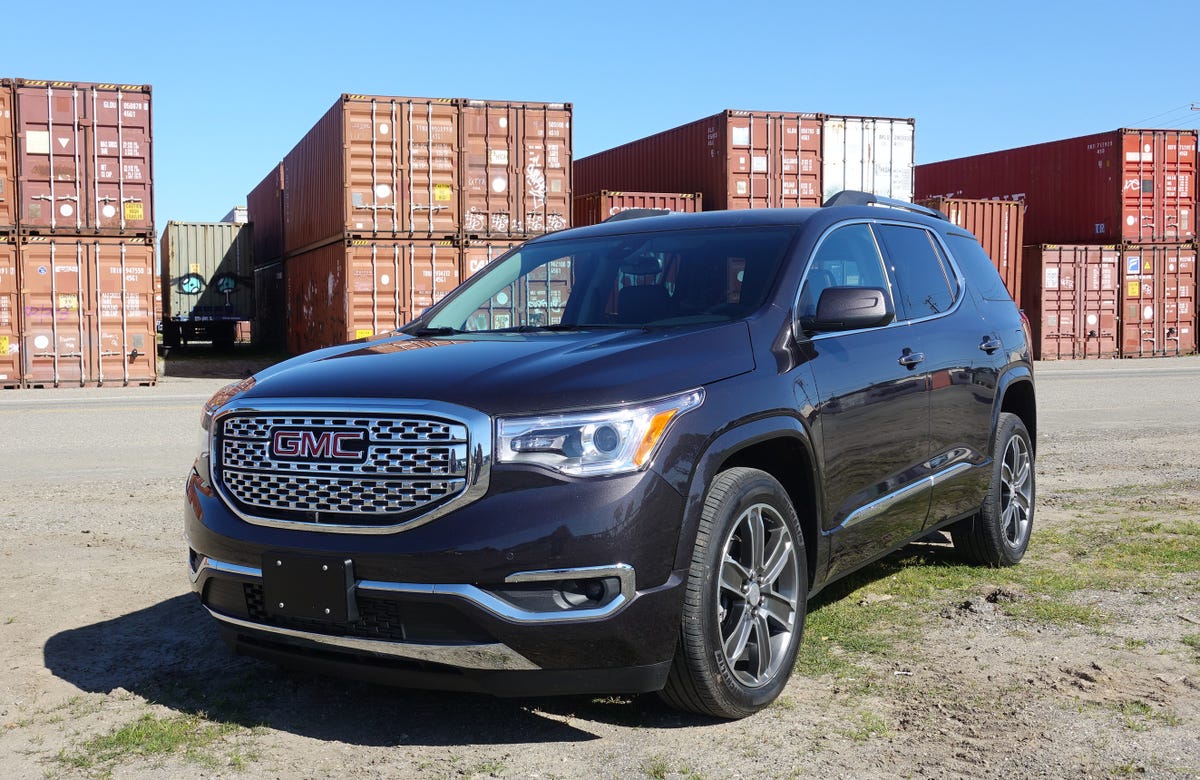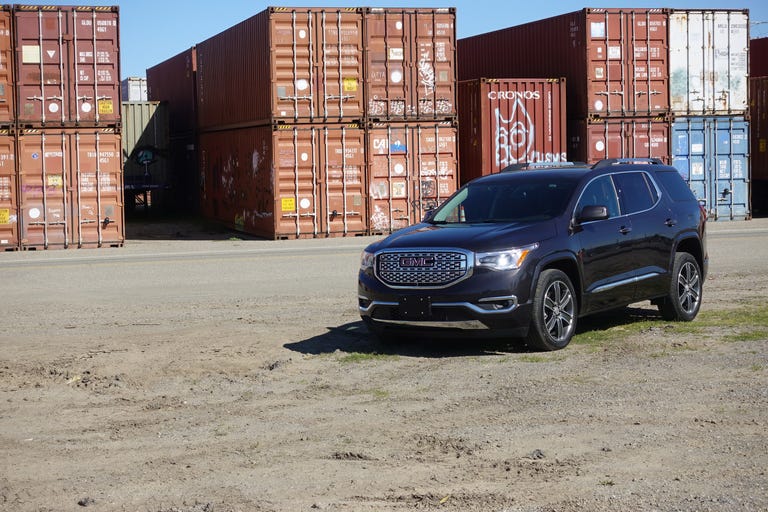 Why You Can Trust CNET
Why You Can Trust CNET 2017 GMC Acadia Denali review: 2017 GMC Acadia Denali: High price for Denali trim means a walk down the line
The luxury-focused Denali trim line adds a few cosmetic touches and extra tech... and a high price tag as well.
Cast your mind back to 2007. The iPhone had just been released, your mom wasn't on Facebook yet and Twitter still hadn't reached its first birthday. Now think about how much all that has changed. You could say the same for the 2017 GMC Acadia.
The Good
The Bad
The Bottom Line
Getting its first redesign since 2007, the three-row Acadia SUV, with room for six or seven, sports improvements across the board. It's lighter, it handles better and it has more safety equipment. It's also smaller, has less room inside and costs a bit more than the competition.

Smaller and blingier is a pretty apt description of the 2017 GMC Acadia Denali.
The Acadia comes in six trim lines, and as is usually the case, the folks at GMC sent me the top-of-the-line Denali. This luxury-oriented trim line, available on all GMC models, distinguishes itself with flashy touches of chrome on the outside and bits of leather and wood on the inside. Special grille full of chrome? Check. Bright aluminum 20-inch wheels? Check, again. Dual chrome exhaust tips? You don't even need to ask, amigo.
The Acadia Denali comes standard with second-row captain's chairs or an available bench seat. The captain's chairs are comfortable, and heated, but I don't advise anyone but children attempt the third row.
The Driver Alert Package II, standard on the high-end Denali trim, includes blind-spot monitoring, pedestrian detection, lane-keeping assist and a safety alert driver's seat that vibrates when you mess up behind the wheel.
Adaptive cruise control with full-speed automatic braking is optional on the Denali and not available on any other trim lines. While trying out the system in San Francisco's notorious all-day and all-night traffic, I found that, while the technology brings the Acadia to a complete stop, the system disengages right away. Other adaptive cruise control systems give a 3-second pause, but the Acadia requires a tap on the gas right away to get it going again. Further, when the car starts to move, it does so with a disarming jerk. I expected more from technology with a price tag of $1,345.
Those looking for driver's aids could also look to Toyota or Honda. The Toyota Highlander has room for eight, besting the Acadia Denali, and comes with Toyota's Safety Sense standard across all trim lines. Honda Sensing technology is standard on the upper trim levels of the three-row Pilot and available on everything but the base model. These Toyota and Honda driver aid packages come with adaptive cruise control, lane-keeping assist and precollision braking. Honda Sensing adds in road departure mitigation while the Toyota package has automatic high beams.
Looks like I have a perfect report card!
The Acadia comes with GM's IntelliLink infotainment system, featuring large buttons on the touchscreen and an easy-to-use interface. An 8-inch screen with navigation is standard on the Denali trim, and Apple CarPlay and Android Auto are standard regardless of trim. The system has 4G LTE connectivity and the Teen Driver platform, which keeps tabs on new drivers and reports to parents how many times the traction control engaged or if any speed limits were broken. Sure, it's a bit of a buzzkill for new drivers, and I would have decried it when I was 16, but in the end it helps parents keep tabs on their Little Darlings.
If you need to charge your gear, have no fear. There is a 120-volt outlet in the rear of the center console and there are USB ports in all three rows of the Acadia Denali, so the kiddos can watch Netflix to their hearts' content on road trips instead of, you know, talking to the family.
SUV Lipo
GMC cut enough weight off the Acadia's chassis to qualify it as a Beverly Hills plastic surgeon. Compared with the previous generation, the 2017 model is 3.5 inches slimmer, 6.4 inches shorter in height and 7.2 inches shorter in length. Cutting out all that sheet metal means the Acadia lost 700 pounds and is now a solid midsize, not full-size SUV.
The bummer is that it's lost some interior space. Behind the third row seats you'll find 12.8 cubic feet of space with 41.7 cubes behind the second row and 79 cubes in total. The third row folds totally flat, which is good, but the previous model had 116 cubic feet of space. The Chevrolet Traverse, riding on the Acadia's old platform, still has that kind of capacity, or take a look at the new Volkswagen Atlas, which has 96.8 cubic feet of space behind the front seats.
The good news is that the decidedly smaller platform makes the 2017 Acadia drive decidedly better. My Denali tester came in all-wheel drive with a 3.6-liter engine, although front-wheel drive is available as well as a smaller 2.5-liter engine on lower trim lines. The Denali spits out a respectable 310 horsepower and 271 pound-feet of torque, although speed demons should take a gander at the Ford Explorer with the EcoBoost V6, good for 365 horses and 350 pound-feet of torque.
Yup, that's a Sport mode.
Still, the Acadia Denali doesn't feel underpowered and acceleration is strong. There are even five different drive modes to choose from, including a Sport mode that makes the acceleration almost fun off the line. Its smaller size gives the Acadia more of a carlike feel behind the wheel, enhanced by the optional $1,200 computer-controlled dampening system. It keeps the car smooth and easy on the pavement, soaking up bumps and harsh pavement like it ain't no thang.
EPA fuel ratings are the same for both the front-wheel and all-wheel drive trains: 18 miles per gallon in the city and 25 miles per gallon on the highway. That's about in line with the Honda Pilot, but mileage misers might do well with the Toyota Highlander in hybrid form, which gets 30 miles per gallon in the city.
A towing package is available for $650, which ups the maximum trailer weight from 1,000 pounds to 4,000 pounds. That's enough to tow a few quads or jet skis, but the Ford Explorer can drag a bit more behind it and the Dodge Durango can be optioned to tow a whopping 7,400 pounds, albeit with an available V8 engine.
Inside, the Denali has heated and cooled front seats, a heated steering wheel and some wood accent panels. Nothing about the Denali screams luxury, and it's not worth the extra 20 grand or so over the base model. Considering I found the adaptive cruise control to be a bit jarring, I'd rather eschew that tech altogether and save some money with an Acadia in SLE-2 trim with all-wheel drive and the 3.6-liter engine. For $790 I'd add the Driver Alert I package with blind-spot monitoring, rear cross-traffic alert and rear park assist. This packaging saves nearly $11,000 over the Denali. Unfortunately, the more comprehensive Driver Alert II package is not available on the SLE-2, so if you're determined to have lane-keeping assist and the like you'll have to move up a trim level. If you're dead-set on herky-jerky adaptive cruise control, you're stuck with the Denali.
Emme's Comparable Picks
Other high-end three-row SUVs start below the Acadia Denali. A top-of-the-line Mazda CX-9 starts at just over $40,000, a similarly equipped Dodge Durango Citadel starts at $41,395 and the Toyota Highlander Limited can be had starting at $41,680.
In comparison, the 2017 GMC Acadia Denali starts at $45,995 for the front-wheel drivetrain, but my test model with all-wheel drive, the technology package, optional computerized dampers, special paint and destination has a final retail price of $50,875. It's a good overall performer, offering a comfortable ride and satisfying handling, but the Denali trim line isn't quite worth the money.


